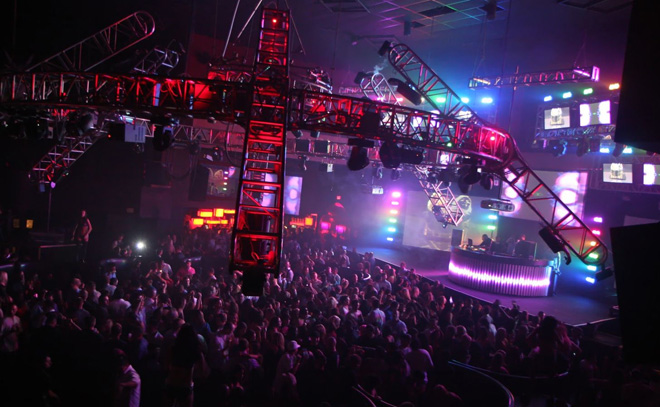Now’s the time for end-of-the-year trend pieces, and one from Mixmag caught our attention: “EDM Will Eat Itself: Big Room Stars are Getting Bored.” Mainly, taking a general approach, Mixmag explains that EDM’s top performers are looking elsewhere.
In a sense, this trend isn’t unique to 2013. Producer prodigies started talking about writing film scores in 2012, with Skrillex going ahead and working on Spring Breakers. From there, if you solely look at mainstream trends, Zedd performed on television with a piano, rather than a laptop and controller, and U.K. garage act Disclosure’s random success on the Billboard charts and Daft Punk’s summer hit indicate electronic dance music fans want to get away from the big synths and drop structure that makes a fair amount of mainstream dance music sound the same.
Then, by fall 2013, Avicii’s True dropped. Although the album as a whole isn’t particularly impressive, it symbolically indicates a new direction for mainstream dance music – that producers may start coming out from behind their computers and software and using actual musicians.
For those with a broader scope of dance music history and knowledge, this notion isn’t revolutionary. Beyond simply bringing a house singer or pop star onto a track, dance music history sporadically has involved instruments, from disco’s beginnings throughout synthpop acts’ decision to occasionally use live guitars, bass, and drums with synthesized and programmed instrumentation to electronica’s blurred lines between keyboards, live drums, and programming.
But Avicii isn’t performing to this listener; instead, his primary demographic considers David Guetta “old school,” thinks Hardwell’s the best DJ out there, and likely hasn’t heard a song with a proper house singer, let alone a guitar with a four-to-the-floor beat. For this group, True opens the door to many possibilities, from the disco influence on “Lay Me Down” to the country-house blend on the ubiquitous “Wake Me Up.”
Just as mediocre 1927 film The Jazz Singer opened up the path to talkies in cinema, True, rather than “Get Lucky” or Disclosure’s Settle, does the same for modern EDM to be more inclusive of instruments and a greater palette of sounds.
Avicii, too, has realized this, and understands that, either for his career or to keep house music relevant, it has to evolve. “
Avicii’s sentiment, however, is a bubbling at the surface of what’s looking to be an overall trend within progressive house music and other mainstream subgenres. Earlier this year when promoting Random Access Memories, Daft Punk proclaimed they didn’t use any computers while recording the album, but more recently, Paul Oakenfold, in speaking about his approach for upcoming album Pop Killer with Rolling Stone, talked about doing something different with samples. “In terms of technology it’s very difficult because everyone’s got access to the same sounds,” he explained. “So that makes it very difficult to do so you have to really dig deep to try and find those moments.”
Oakenfold, on the other hand, doesn’t appear to be looking to create something entirely revolutionary – at least not along the lines of bringing live musicians on Pop Killer. According to reports, his album will feature top 40 artists like Azealia Banks and Miguel. Simply, just looking at his statements at face value, the producer with a two decade-plus career doesn’t want to sonically blend in with every other artist within the Beatport top 10.
The Money-Making Formula
Ultimately, what Daft Punk, Avicii, and Oakenfold are going against in varying degrees is a money-making formula for dance music – a group of sounds and structure that create a hit that ranks highly not just on Beatport but ultimately the Billboard charts, including the coveted Hot 100.
 History lets Daft Punk get away with working in the studio with musicians, but for a moment, Avicii’s True looked to be a flop. The outrage at his bringing live musicians on stage at the 2013 Ultra Music Festival surfaced not just from the crowd’s disgruntled reaction, heard clearly in recordings from that night, but also through other producers’ own tweets – some comparing him to ‘90s Eurodance act Rednex. When your peers turn against you for doing something different, the task of taking that path appears even more daunting.
History lets Daft Punk get away with working in the studio with musicians, but for a moment, Avicii’s True looked to be a flop. The outrage at his bringing live musicians on stage at the 2013 Ultra Music Festival surfaced not just from the crowd’s disgruntled reaction, heard clearly in recordings from that night, but also through other producers’ own tweets – some comparing him to ‘90s Eurodance act Rednex. When your peers turn against you for doing something different, the task of taking that path appears even more daunting.
However, in looking at the hordes of burgeoning, amateur producers sending him requests on Soundcloud, Xavier Mafe at TheFrontliner.com found that the “EDM formula” goes deeper than the top 10 tracks on Beatport; rather, the seeming ease of success producer prodigies have found, between doing hundreds of gigs per year and putting out hit-making tracks, makes EDM look like a quick path to being rich and famous.
The result appears to be half-baked progressive house and brostep tracks that all follow the same formula – most of which simply sit on the internet waiting to be found.
Of course, hundreds of kids playing around with synths and composing drops with Ableton and other software is the base level of an overall shift in electronic dance music: That there’s no space for experimentation. “There’s a manual now,” Richie Hawtin said in an interview at SXSW. “The attraction was doing something different. I had to do my own thing. The double-edged sword is taking a little bit of the life out of it. Maybe that’s why EDM is so big now. It’s homogenized.”
But just as Daleri’s “Epic Mashleg” revealed how much modern dance music hits sound the same to a certain degree, Hawtin’s assertion is right. If you took a sampling of electronic artists from the time Hawtin emerged in the ‘90s, from fading synthpop acts to acid house to Detroit techno to Eurodance hits, you’d find similar analog tools used, but each with varying structures, combinations, and textures.
However, from the hundreds of one-hit Eurodance acts churned out over the ‘90s to Kevin Saunderson’s own label for Detroit techno releases to the Pet Shop Boys bringing sessions musicians on their albums, creativity (or at least experimentation) hadn’t been suppressed excessively by a high price tag for performing or major label expectations. It was the time a cultural institution like the Hacienda could go on for years without making money; these days, electronic dance music has SFX Entertainment and Live Nation wondering why the ROI isn’t greater.
But with higher prices, including what a top DJ/producer can earn per night in Las Vegas these days, comes greed. Beyond the novice naively thinking he can make a hit and become the next Skrillex, this resulted in Pacha Ibiza’s managers canceling contracts with its regular performers like Erick Morillo, Tiesto, Luciano, and Pete Tong, some of whom find they can play less and earn more in Sin City. “It was an abuse,” José Urgell, part of the family that owns Pacha Ibiza, told the New York Times. “We had to come up with a new plan because the old one was going to explode.”
Instead of cave, as the New York Times reveals, Pacha Ibiza is attempting to reinvent itself by bringing on more underground performers who don’t expect six figures for a two-hour set.

History Repeats Itself
As what the future holds in store for EDM looks uncertain, dance music looks to align itself with hip-hop again.
Considering older electronic sounds became more in vogue this year, this doesn’t appear implausible. History has both crossing over at various points: From disco and the early days of house to Arthur Baker producing Afrika Bambaataa and New Order in the early ‘80s to the rap verse element of countless Eurodance hits in the ‘90s to the Pet Shop Boys’ “West End Girls” and other synthpop artists trying their hands at it. With producers like Diplo and David Guetta already crossing over to work with a handful of hip-hop artists, the shift looks like it’s already taking place.
But the next change, based on mainstream commercial trend barometers, is the EDM hip-hop album – something Waka Flocka Flame, while on tour with Steve Aoki, stated he would do. From a commercial standpoint, it works. Rap’s declining sales and fewer tours, according to Marcus K. Dowling in HipHopDX, could be bolstered by siding with dance music again. But, Dowling cautions, such an approach essentially means hip-hop getting back to its roots: “If we want to again discover that organic essence that fueled what Rap music became before commercialism and greed reared their ugly heads, that would be the most likely location for that necessary discovery.”
What 2014 holds for mainstream dance music will start to unfold in subsequent months – and that could be anything from a new rap-EDM album to a talent shift during Ibiza’s summer season to greater acceptance of live instruments within the latest progressive house. We’ll just have to wait and see.




